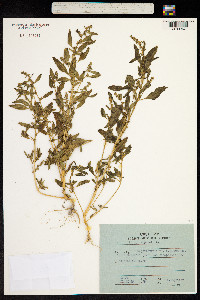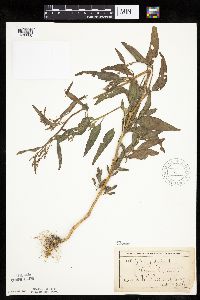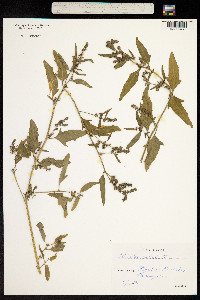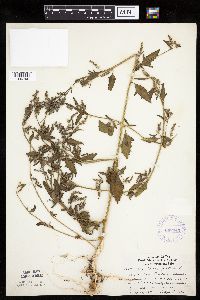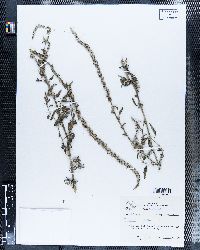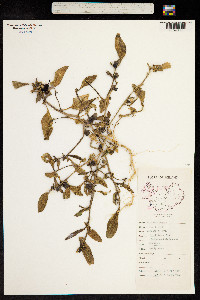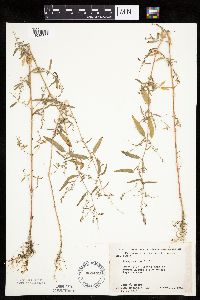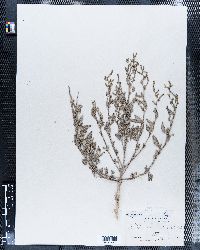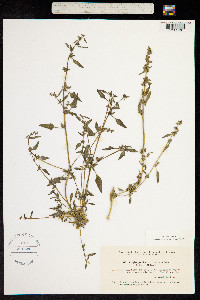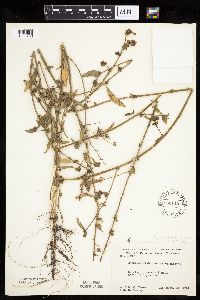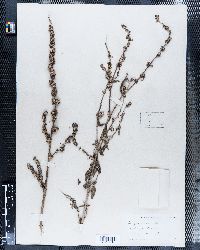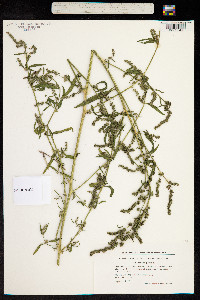Atriplex patula
|
|
|
|
Family: Amaranthaceae
Halberd-Leaf Orache
[Atriplex patula var. bracteata, moreAtriplex patula var. erecta , Atriplex patula var. japonica , Chenopodium zosterifolium] |
Herbs, monoecious or subdioe-cious, (1.5-)3-9(-15) dm. Stems mostly erect and branched, branches green, obtusely angled or striate, glabrate. Leaves alternate except the proximalmost, petiolate; blade green on both sides, rhombic-lanceolate to lanceolate, oblong, or narrowly lance-oblong or hastate-ovate, 25-120 × 3-40(-75) mm, entire or toothed, proximal ones broadly cuneate or sometimes hastate subbasally with obliquely antrorse basal lobes, distal cauline leaves lanceolate and entire. Flowers compact or interrupted spiciform or paniculiform clusters. Staminate flowers mostly 5-merous. Fruiting bracteoles green becoming black, rhombic to rhombic-triangular, or ovate-rhombic, compressed, ± uniformly sized, 2-7(-20) mm, base mostly hastate, acute, margin united almost to middle, entire or sparingly toothed, surfaces tuberculate. Seeds dimorphic: brown, 2.5-3(-3.5) mm wide, or black, 1-2 mm wide; radicle of brown seeds subbasal to median, antrorse. 2n = 36. Flowering summer-fall. Widespread ruderal weed of nonsaline substrates such as fields, gardens, and roadsides; 0-2100 m; Alta., B.C., Man., N.B., Nfld. and Labr. (Nfld.), N.S., Ont., Que., Sask., Yukon; Ala., Alaska, Calif., Colo., Del., D.C., Idaho, Ill., Ind., Iowa, Maine, Md., Mass., Mich., Mo., Mont., Nev., N.H., N.Y., N.C., N.Dak., Ohio, Pa., R.I., S.Dak., Utah, Vt., Va., Wis., Wyo.; Europe; Asia; n Africa. Atriplex patula appears to have been a rather recent introduction in North America from Eurasia, not arriving perhaps until sometime in the early to mid-eighteenth century. It simulates depauperate specimens of A. dioica, A. glabriuscula, and other similar species when leaves are reduced to a near-linear profile. Such specimens are difficult if not impossible to assign to any of the species.
Annual herb 30 cm - 1.5 m tall Stem: upright, widely branched, branches green and angled or grooved. Leaves: alternate (except lowest ones), stalked, 2.5 - 12 cm long, 3 mm - 4 cm wide, lance-shaped to diamond-shaped or narrowly oblong lance-shaped to arrowhead- egg-shaped, sometimes sparsely toothed, more or less mealy. Inflorescence: a compact or interrupted spike of flowers or a branched cluster of flowers (panicle), numerous. Flowers: either male or female, borne on the same plant (monoecious), greenish, tiny. Male flowers with five sepals and stamens, no petals. Female flowers without petals and sepals, enclosed within a pair of small, leaf-like bracts (bracteoles). Stigmas two. Fruit: enclosed within a pair of small bracts (bracteoles). Bracteoles united almost to middle, green becoming black, mostly 2 - 7 mm long, diamond-shaped to triangular or diamond- egg-shaped with an arrowhead-shaped base and pointed tip, compressed, sometimes sparingly toothed, smooth or with small, irregular projections. Seeds brown and 2.5 - 3.5 mm wide or black and 1 - 3 mm wide. Similar species: The similar Atriplex prostrata differs by the shapes of its leaves, which are often toothed. Flowering: August to September Habitat and ecology: Introduced from Eurasia. Found in a wide variety of disturbed habitats, including lawns, gardens, parkways, and waste ground. May also be found along highways because it tolerates a high degree of salinity. Occurence in the Chicago region: non-native Etymology: Atriplex is the ancient Latin name for this plant. Patula means spreading. Author: The Morton Arboretum Plants to 1(-1.5) m, erect and widely branched, or sometimes ±prostrate; lvs green especially on the upper side, the principal ones 4-12 cm, lanceolate to rhombic- hastate with a cuneate base; infls numerous, interrupted-spiciform, more continuous upwards, leafy- bracteate only near the base; fruiting bracteoles thin, foliaceous, joined near the base or almost to the middle, obscurely veined or only the midvein prominent, mostly 3-7 mm, ovate to more often rhombic- triangular or triangular-hastate, acute to acuminate, entire or with 1 or 2 short lateral teeth, smooth or with irregular appendages on the back; seeds dimorphic, some brown, 2.5-3.5 mm wide, others black, smaller, 1.2-3 mm wide; radicle ±inferior; mainly or wholly tetraploid on x=9. Widespread ruderal weed, only casually maritime, intr. from Eurasia. (A. acadiensis) Gleason, Henry A. & Cronquist, Arthur J. 1991. Manual of vascular plants of northeastern United States and adjacent Canada. lxxv + 910 pp. ©The New York Botanical Garden. All rights reserved. Used by permission. From Flora of Indiana (1940) by Charles C. Deam A highly variable species and linked by intermediates with its varieties. In sandy soil and waste places ...... Indiana Coefficient of Conservatism: C = null, non-native Wetland Indicator Status: FACW Diagnostic Traits: lowest leaves opposite, hastate to linear, with cuneate bases and scurfy scales; flowers all unisexual and female ones borne between conspicuous, deltate bracteoles.
|










